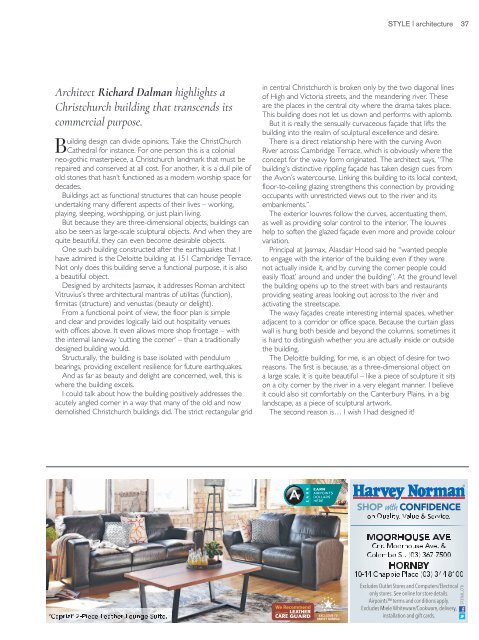You also want an ePaper? Increase the reach of your titles
YUMPU automatically turns print PDFs into web optimized ePapers that Google loves.
STYLE | architecture 37<br />
Architect Richard Dalman highlights a<br />
Christchurch building that transcends its<br />
commercial purpose.<br />
Building design can divide opinions. Take the ChristChurch<br />
Cathedral for instance. For one person this is a colonial<br />
neo-gothic masterpiece, a Christchurch landmark that must be<br />
repaired and conserved at all cost. For another, it is a dull pile of<br />
old stones that hasn’t functioned as a modern worship space for<br />
decades.<br />
Buildings act as functional structures that can house people<br />
undertaking many different aspects of their lives – working,<br />
playing, sleeping, worshipping, or just plain living.<br />
But because they are three-dimensional objects, buildings can<br />
also be seen as large-scale sculptural objects. And when they are<br />
quite beautiful, they can even become desirable objects.<br />
One such building constructed after the earthquakes that I<br />
have admired is the Deloitte building at 151 Cambridge Terrace.<br />
Not only does this building serve a functional purpose, it is also<br />
a beautiful object.<br />
Designed by architects Jasmax, it addresses Roman architect<br />
Vitruvius’s three architectural mantras of utilitas (function),<br />
firmitas (structure) and venustas (beauty or delight).<br />
From a functional point of view, the floor plan is simple<br />
and clear and provides logically laid out hospitality venues<br />
with offices above. It even allows more shop frontage – with<br />
the internal laneway ‘cutting the corner’ – than a traditionally<br />
designed building would.<br />
Structurally, the building is base isolated with pendulum<br />
bearings, providing excellent resilience for future earthquakes.<br />
And as far as beauty and delight are concerned, well, this is<br />
where the building excels.<br />
I could talk about how the building positively addresses the<br />
acutely angled corner in a way that many of the old and now<br />
demolished Christchurch buildings did. The strict rectangular grid<br />
in central Christchurch is broken only by the two diagonal lines<br />
of High and Victoria streets, and the meandering river. These<br />
are the places in the central city where the drama takes place.<br />
This building does not let us down and performs with aplomb.<br />
But it is really the sensually curvaceous façade that lifts the<br />
building into the realm of sculptural excellence and desire.<br />
There is a direct relationship here with the curving Avon<br />
River across Cambridge Terrace, which is obviously where the<br />
concept for the wavy form originated. The architect says, “The<br />
building’s distinctive rippling façade has taken design cues from<br />
the Avon’s watercourse. Linking this building to its local context,<br />
floor-to-ceiling glazing strengthens this connection by providing<br />
occupants with unrestricted views out to the river and its<br />
embankments.”<br />
The exterior louvres follow the curves, accentuating them,<br />
as well as providing solar control to the interior. The louvres<br />
help to soften the glazed façade even more and provide colour<br />
variation.<br />
Principal at Jasmax, Alasdair Hood said he “wanted people<br />
to engage with the interior of the building even if they were<br />
not actually inside it, and by curving the corner people could<br />
easily ‘float’ around and under the building”. At the ground level<br />
the building opens up to the street with bars and restaurants<br />
providing seating areas looking out across to the river and<br />
activating the streetscape.<br />
The wavy façades create interesting internal spaces, whether<br />
adjacent to a corridor or office space. Because the curtain glass<br />
wall is hung both beside and beyond the columns, sometimes it<br />
is hard to distinguish whether you are actually inside or outside<br />
the building.<br />
The Deloitte building, for me, is an object of desire for two<br />
reasons. The first is because, as a three-dimensional object on<br />
a large scale, it is quite beautiful – like a piece of sculpture it sits<br />
on a city corner by the river in a very elegant manner. I believe<br />
it could also sit comfortably on the Canterbury Plains, in a big<br />
landscape, as a piece of sculptural artwork.<br />
The second reason is… I wish I had designed it!


















